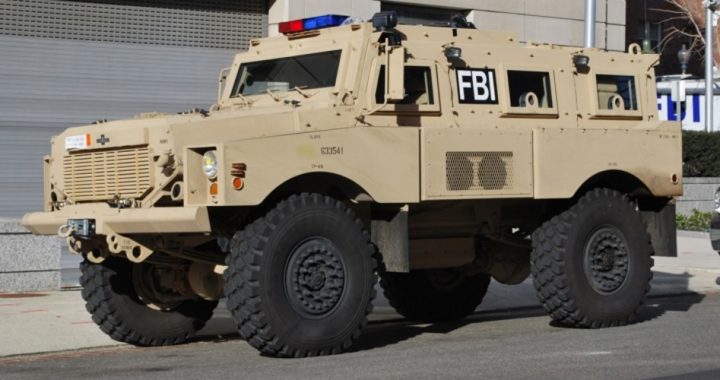
The National Tactical Officers Association, the lobbying group for 1,600 SWAT teams across the country, e-mailed all legislative staffers in the U.S. House and Senate this week, the Daily Beast reported, and assured the legislative aides that its members share “our nation’s grief” over the rioting in Ferguson, Missouri. But the main message from the NTOA was a plea to protect the federal program that gives surplus military weapons and equipment to state and local police. The program has become subject of national debate, given the highly visible “warrior cop” image of police during the uprising in Ferguson.
“The police have to be one step ahead of the criminal element, have to be prepared for the worst-case scenario. You don’t want a community to be taken over by one or many criminals,” NTOA Executive Director Mark Lomax told the Daily Beast. “We’re definitely for equipping our law enforcement officials out there properly, with proper training and proper policies.”
The sight of police in a small American city (Ferguson pop. 21,135) in full riot gear with automatic weapons and armored vehicles has raised concerns on Capitol Hill over a national militarization of local police forces, and a blurring of the lines between law enforcement and military combat.
Sen. Rand Paul (R-Ky.) is considering introducing a bill to prohibit the transfer of military equipment to law-enforcement officials, the Daily Beast reported, while some Republicans in the GOP-controlled House, where all revenue bills must originate, are talking of “defunding ” the Pentagon’s weapons transfer program.
On the Democratic side, Rep. Hank Johnson of Georgia said he has been at work since long before the Ferguson events on a bill that would bar transfer to local police of the Pentagon’s armored personnel carriers, drones, assault weapons, and aircraft.
“My main hope is to stop the flow of this military-grade equipment to local law enforcement agencies throughout America,” Johnson told radio host Brad Friedman in a “Bradcast” on KPFK/ Pacifica Radio in Los Angeles. “We’ve been flooding the streets with this surplus military weaponry, and I think the situation in Ferguson exemplifies what happens when you have too much powerful equipment in the hands of folks who don’t have the judgment or the training to utilize it properly.”
Sen. Carl Levin (D-Mich.) issued a statement indicating a more cautious approach, calling for a “review” of the weapons transfer program. “Congress established this program out of real concern that local law enforcement agencies were literally outgunned by drug criminals,” Levin said. “We will review this program to determine if equipment provided by the Defense Department is being used as intended.”
Among the military items that were seen during the Ferguson riots, none appears to have generated more controversy than the tank-like Mine Resistant Ambush Protected (MRAP) vehicles. While there were reports of Molotov cocktails thrown at police, no evidence has yet surfaced of rioters planting land mines in Ferguson or other U.S. cities.
“There [is] no need to roll in urban warfare equipment, anticipating and wanting a battle with citizens who only demand answers,” Malik Aziz, chairman of the National Black Police Association, told the Daily Beast. “In many cities the acquisition of these MRAPs and other tools [is] almost useless…. Most of these MRAPs are too big and bulky and not designed for urban environments.”
Some critics say the presence of MRAPs escalates tensions and triggers further violence, a claim disputed by John Adler, president of the Federal Law Enforcement Association.
“The presence of an MRAP for defensive positioning should not unnerve a law-abiding citizen,” Adler said. “Police officers are human and bleed like everyone else. They deserve the best protection from violent assaults, and providing them with MRAPs or advanced body armor minimizes their exposure to serious injury or death.”
Mike Willis, executive director of the United States Deputy Sheriff’s Association, said possible uses for MRAPs in an urban setting include transportation in extreme flooding and protection from bullets or Molotov cocktails.
It is somewhat surprising that members of Congress and many in the nation have been awakened about militarization of police during the Ferguson riots, when even more armored vehicles and other military hardware were on display in Greater Boston in April 2013, when law enforcement shut down entire cities and conducted house to house searches in pursuit of marathon bomber suspect Dzhokhar Tsarnaev. Perhaps the public was willing to concede more leeway to law enforcement in pursuit of a bombing suspect who allegedly killed three people and wounded dozens of others at a public event than to officers responding to protests and riots over the police shooting of an unarmed black man.
Another question that appears to be overlooked is, why is it that the Defense Department has so much surplus equipment to give away? It appears obvious that the weapons and other combat gear are still functional or the Pentagon wouldn’t be assigning them for use by local police departments. So why is it the military has so many more armored vehicles, automatic rifles, drones, planes, etc. than it needs?
Perhaps what Congress should be reviewing, along with the weapons transfer program, is its overall defense appropriations.



